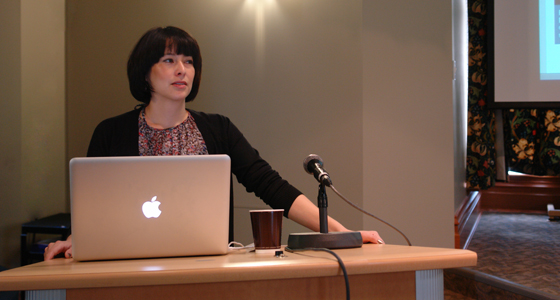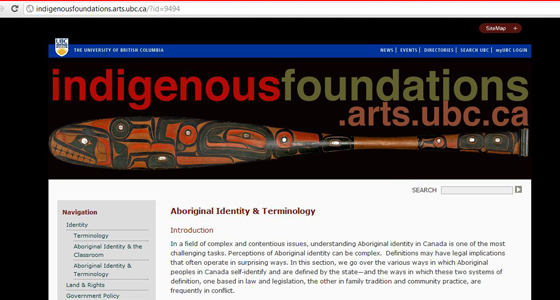 Many students come to class with previously formed ideas about course topics. One of the most vital roles for professors is to get students to think critically about these preconceived notions. As part of the series on Classroom Climate: Aboriginal Initiatives, Dr. Dory Nason presented a workshop on Critical Thinking and Representation in Student Writing. Dr. Nason holds a joint position with the First Nations Studies Program and the Department of English, and in the workshop, she shared her tips and tricks on how to get students to think critically about their work and ideas. The focus of the workshop was specifically geared towards getting students to understand how to ethically represent the experiences of Aboriginal peoples.
Many students come to class with previously formed ideas about course topics. One of the most vital roles for professors is to get students to think critically about these preconceived notions. As part of the series on Classroom Climate: Aboriginal Initiatives, Dr. Dory Nason presented a workshop on Critical Thinking and Representation in Student Writing. Dr. Nason holds a joint position with the First Nations Studies Program and the Department of English, and in the workshop, she shared her tips and tricks on how to get students to think critically about their work and ideas. The focus of the workshop was specifically geared towards getting students to understand how to ethically represent the experiences of Aboriginal peoples.
How to Write the Great American Indian Novel
For Dr. Nason, the first step is for students to think critically of themselves, their background, and their expectations of Aboriginal peoples. She recommends beginning the first class with a poem by Sherman Alexie, “How to Write the Great American Indian Novel,” from the book Summer of Black Windows. Dr. Nason uses this poem in her first class because “it gets students to think through their expectations.” Dr. Nason and the students work through the poem together. They notice how the structure, language, and imagery of the poem forces the reader to think through their own expectations of Aboriginal peoples. The first thing students notice is that the poem is “prescriptive.” The “critical point,” is when the students notice that it is not Aboriginal peoples who write their own story. As the poem states, Aboriginal peoples are often left out of the dialogue, and are “ghosts” to their own story. Dr. Nason notes that she also begins with the poem because it sets up an important pervasive topic, “the narrative discourse of the vanishing Indians.” There is a misconception that “Aboriginal peoples are a thing of the past,” that they are “ghosts.”In relation to the misconception of the “vanishing Indian,” the poem also sheds light on the idea that non-Natives perceive “authentic” Aboriginal peoples as something of the past.
How Do You Prepare Students?
 So how should you, as a professor, librarian, or TA, prepare students to address topics related to Aboriginal peoples in their writing? Starting from day one, Dr. Nason recommends others to anticipate that many students “won’t have the language or terminology” to express themselves properly. She also mentions that you should also anticipate that many students will have previously formed ideas about Aboriginal peoples. As a first step to getting students to understand how to be conscious of the language they use, Dr. Nason refers students to the Indigenous Foundations webpage on identity and terminology. Dr. Nason states that “this is also a good way to hold students accountable for knowing these things.” Furthermore, by reading the webpage on terminology, Dr. Nason hopes to get students to think critically about the language they use. She hopes it will get students to think about how some terms that are often used to describe Indigenous peoples, relate to “larger social structures.” In addition to terminology, Dr. Nason discussed the various framing narratives or discourses that shape student thinking in problematic ways. As previously mentioned, the discourse of the “vanishing Indian” often shapes thinking on contemporary topics. Relatedly, the discourse of progress tends to shape student thinking on how “best” to address Aboriginal topics. For example, Dr. Nason notes how notions of progress, or the binary or savage versus civilized, underpins how students tend to write about the “modern Indian” versus writing about contemporary Indigenous communities in complex ways. The use of correct terminology and understanding these dominant discourses is very important. Dr. Nason finds that a lot of times students come up with research topics which are not problematic but when phrased as research questions become indicative of problematic terminology and ways of thinking. Dr. Nason notes, however, that professors, librarians, and TA’s should keep in mind that many of the students that use the wrong terminology or framing concepts are really just picking up on the terms and concepts that many recent scholars of First Nations Studies still use today. Dr. Nason states that it is therefore “important to reinforce the appropriate use of terms throughout the semester,” and discuss the underlying discourses which are being reinforced or challenged by contemporary scholars.
So how should you, as a professor, librarian, or TA, prepare students to address topics related to Aboriginal peoples in their writing? Starting from day one, Dr. Nason recommends others to anticipate that many students “won’t have the language or terminology” to express themselves properly. She also mentions that you should also anticipate that many students will have previously formed ideas about Aboriginal peoples. As a first step to getting students to understand how to be conscious of the language they use, Dr. Nason refers students to the Indigenous Foundations webpage on identity and terminology. Dr. Nason states that “this is also a good way to hold students accountable for knowing these things.” Furthermore, by reading the webpage on terminology, Dr. Nason hopes to get students to think critically about the language they use. She hopes it will get students to think about how some terms that are often used to describe Indigenous peoples, relate to “larger social structures.” In addition to terminology, Dr. Nason discussed the various framing narratives or discourses that shape student thinking in problematic ways. As previously mentioned, the discourse of the “vanishing Indian” often shapes thinking on contemporary topics. Relatedly, the discourse of progress tends to shape student thinking on how “best” to address Aboriginal topics. For example, Dr. Nason notes how notions of progress, or the binary or savage versus civilized, underpins how students tend to write about the “modern Indian” versus writing about contemporary Indigenous communities in complex ways. The use of correct terminology and understanding these dominant discourses is very important. Dr. Nason finds that a lot of times students come up with research topics which are not problematic but when phrased as research questions become indicative of problematic terminology and ways of thinking. Dr. Nason notes, however, that professors, librarians, and TA’s should keep in mind that many of the students that use the wrong terminology or framing concepts are really just picking up on the terms and concepts that many recent scholars of First Nations Studies still use today. Dr. Nason states that it is therefore “important to reinforce the appropriate use of terms throughout the semester,” and discuss the underlying discourses which are being reinforced or challenged by contemporary scholars.
When There is Too Much at Stake
One of the most common problems that Dr. Nason has found with students writing about Aboriginal peoples is that many students feel intimidated by the topic. Students may feel that “there is a lot at stake” when they write. Dr. Nason believes that this can be “quite paralyzing.” She finds that sometimes, students have an “ethical anxiety” when writing about these topics. It’s a good anxiety to have when talking about other people’s issues, but Dr. Nason notes that it is also important to make sure this “ethical anxiety” does not deteriorate into unproductive notions of guilt or paralyzing fear of not knowing enough. In order to tackle this problem and to ensure that students feel comfortable when writing about Indigenous topics, Dr. Nason first assigns a “low stake activity.” As a “low stake activity,” students are assigned reading responses to an article. In the reading responses, Dr. Nason does not overly correct the students; instead, she guides them step-by-step. This allows them to ease into the writing. In higher stakes writing, however, such as in research papers, Dr. Nason does hold her students more accountable to the way they use language and terminology and frame their ideas.
For a final assignment, Dr. Nason finds that it is better to ask students new to First Nations Studies to research what is being said about a First Nations Studies topic in the form of critical literature review, than to get them to develop their own unique argument. Dr. Nason discovered that this approach is better than getting students to write their own argument, because many students come into class with previously formed opinions on Aboriginal peoples. For Dr. Nason, this strategy works better than to get students to write a research paper in a one term course, and then getting back many solution-based essays that lack deeper analysis. The analysis part of the assignment comes from the student commenting on what they thought was missing from the analyses made by scholars in the field thus far. Dr. Nason found that this type of assignment was better because it got students to engage with what was being said in the discipline and to practice being critical readers.
The Problem with the “Helping” Discourse
A topic that was discussed and widely agreed upon in the workshop was the importance of bringing classroom discussions and student writing out of “the helping tone.” A group member said that the “informative missionary dialogue” was not appropriate for discussions related to understanding and researching the history of other peoples, especially with the history of paternalism in Canada’s Indian policies. The group, however, agreed that it was not the students who should be blamed entirely, as some academic environments encourage students to “try and think of a solution.” Dr. Nason concluded with a recommendation of a TED talk by Nigerian fiction writer Chimamanda Adichie, The Danger of a Single Story, which reinforces for students the need to be humble about their position, knowledge, and own preconceived expectations or biases about the “other” throughout their lives.
Below is a summary of writing and stylistic problems that the group found to be the most common in students’ writings about Aboriginal peoples:
Common Issues
- The use of the term “plight.”
- The non-capitalization of the word “Indigenous.”
- The ways in which students absorb the colonial environment, and bring that to their writing. For example the ideas of historical progress in relation to the vanishing Indian, or the idea that the most “authentic” Indian is dead.
- Students that feel the need to give a “solution” when concluding their essays.
- The problematic use of the word “biased.”
- Students taking ownership of the topics relating to First Nations. Instead of holding the author accountable, they write about a certain idea as if it were theirs.
After the group discussion, the engaging workshop came to an end, with many attendees walking away confident and encouraged that they could get their students to reflect and improve upon their own writings of Aboriginal peoples.
Comments are closed, but trackbacks and pingbacks are open.